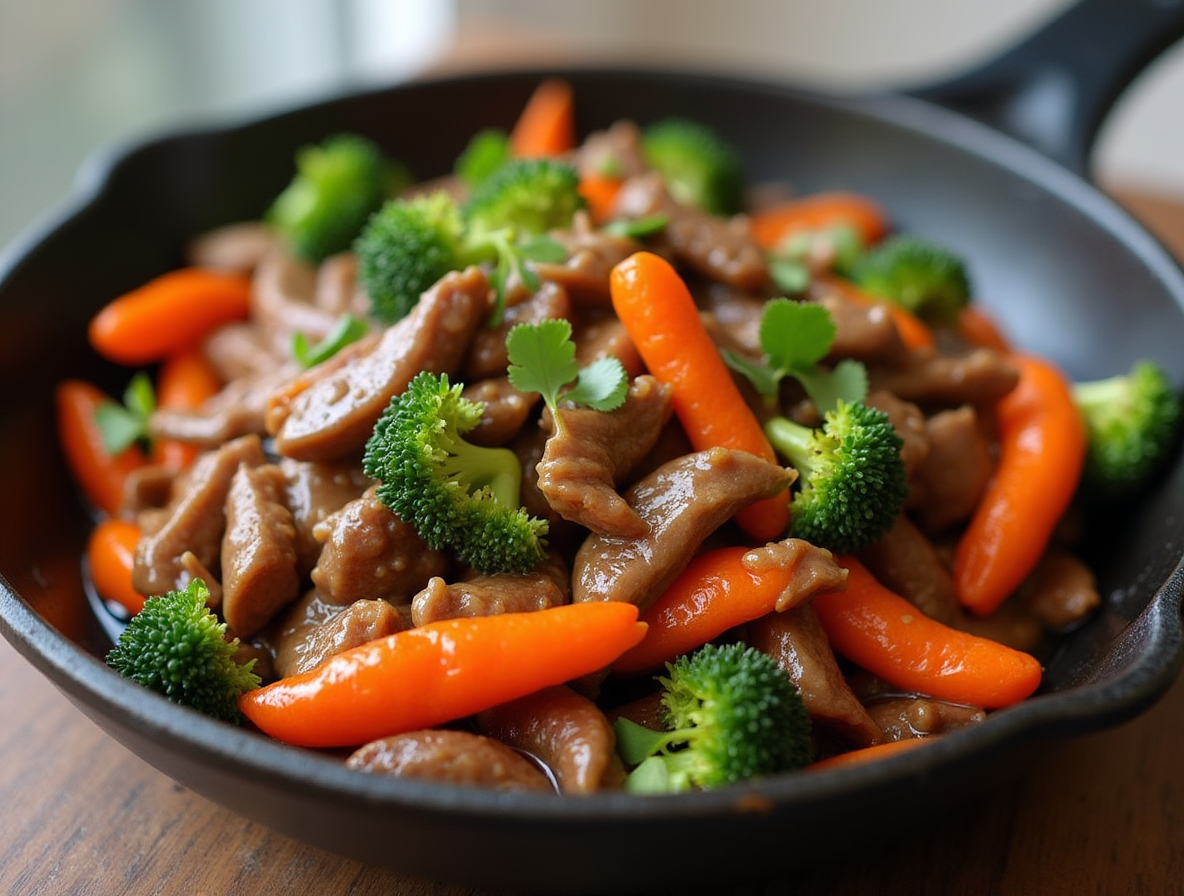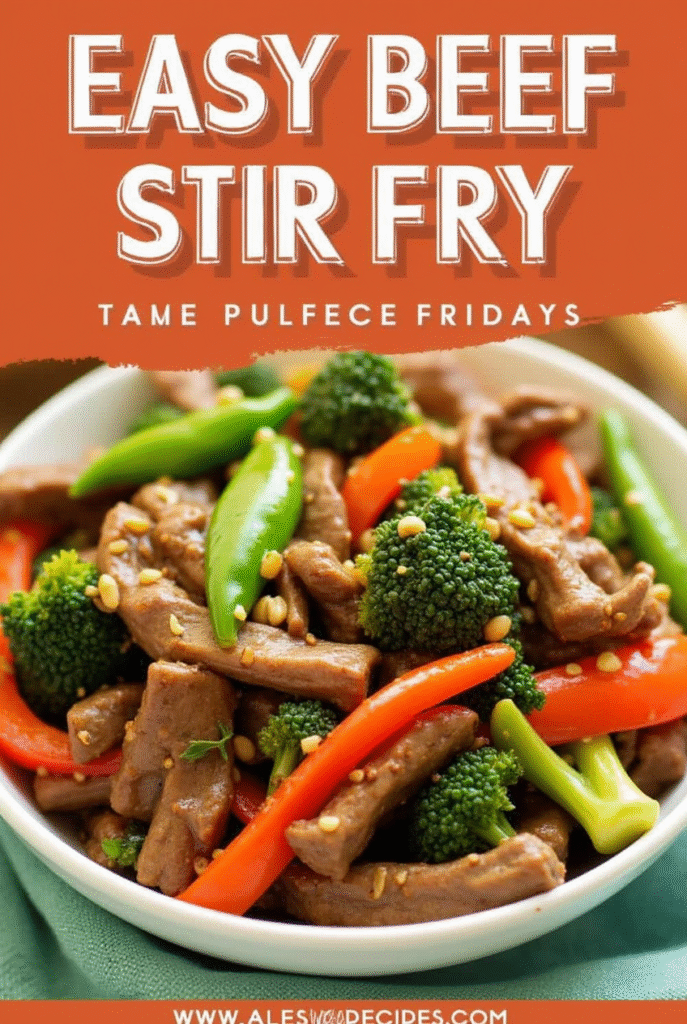Easy Beef Stir Fry Recipe: A Foolproof 20-Minute Dinner Guide
This easy beef stir fry recipe has become our family’s go-to solution for hectic weeknights when time is tight. Ready in just 20-25 minutes and requiring only one pan, it’s the definition of convenience without sacrificing flavor. We’ve discovered that making beef stir fry at home is not only faster than ordering takeout but also healthier and more economical.
When learning how to make beef stir fry, the right cut of meat makes all the difference. Flank steak, skirt steak, and top sirloin are excellent choices due to their tenderness and quick cooking times. Additionally, the beauty of quick beef stir fry lies in its versatility—you can incorporate virtually any vegetables you have on hand, making it perfect for using up leftovers while creating a nutritionally balanced meal with approximately 268 calories and 23g of protein per serving.
Throughout this guide, I’ll walk you through our foolproof method for creating a delicious beef stir fry recipe easy enough for beginners yet impressive enough for dinner guests. From selecting the best high-smoke-point oils to mastering the homemade sauce that rivals your favorite restaurant’s version, you’ll soon have all the skills needed to make this 20-minute wonder part of your regular dinner rotation.
Choosing the Right Ingredients
The secret to creating an exceptional easy beef stir fry recipe starts with selecting ingredients that deliver maximum flavor with minimal cooking time. Making smart choices at the grocery store sets the foundation for a dish that’s both delicious and efficient.
Best cuts of beef for stir fry
Flank steak reigns supreme as the most popular cut for stir-frying, offering intense beefy flavor at a reasonable price point. This versatile cut works beautifully when sliced properly against the grain into thin, quarter-inch strips.
For budget-conscious cooks, beef chuck steak provides a more economical alternative. Though traditionally used for stewing, chuck steak performs admirably in stir-fries when trimmed of excess fat and sliced correctly. The benefit? You can purchase a larger piece, portion it, and freeze for multiple meals.
Other excellent options include skirt steak, which has low moisture content that creates a perfect sear, and sirloin tip, prized for its lean tenderness and rich flavor. Rump steak delivers robust taste despite coming from a more exercised part of the cow.
Vegetables that cook quickly and stay crisp
The ideal stir-fry includes vegetables that maintain their texture and bright colors under high heat. Bell peppers add sweetness and crunch, whereas broccoli florets capture sauce beautifully within their flowery tops.
Snow peas contribute a delightful snap and vibrant green color. Mushrooms require longer cooking time to release their moisture but absorb flavors wonderfully. For aromatics, onions and fresh garlic provide essential foundation flavors.
Consider adding baby corn, water chestnuts, or bean sprouts for interesting textural contrasts. For a more substantial meal, carrots offer sweetness and beautiful color contrast.
Essential pantry items for stir fry sauce
A truly authentic stir-fry sauce requires several key ingredients:
Low-sodium soy sauce forms the foundation of most stir-fry sauces. Look for bottles labeled “naturally brewed” which indicates proper fermentation without synthetic accelerators.
Dark soy sauce provides depth, color, and richness – Pearl River Bridge brand is particularly recommended by Chinese cooking experts.
Sesame oil delivers that distinctive nutty flavor essential to Asian cooking, though it should be used sparingly as it can quickly overpower other ingredients.
Rice vinegar contributes necessary tang, honey or brown sugar adds balanced sweetness, and cornstarch creates that perfect glossy thickness that helps sauce cling to ingredients.
For those seeking authentic flavor, consider adding Shaoxing wine, though dry sherry makes an excellent substitute if unavailable. Oyster sauce provides remarkable umami depth – as professional Chinese chefs often say, “If you want to make a dish taste better, just add oyster sauce”.
With these carefully selected ingredients on hand, your easy beef stir fry will transform from a simple weeknight meal to a restaurant-quality experience in just minutes.
Prepping for Success
Proper preparation makes the difference between a restaurant-quality stir fry and a disappointing dinner. The key to a perfect easy beef stir fry recipe lies in understanding a few fundamental techniques that professionals use to achieve tender, flavorful results.
How to slice beef for tenderness
The secret to perfectly tender beef starts with understanding the “grain” – those long muscle fibers running through the meat. Cutting against the grain (perpendicular to these fibers) shortens them, creating more tender bites. First of all, examine your beef to identify which direction the grain runs, then position your knife to cut across it.
For optimal tenderness, hold your knife at a 45-degree angle and slice the beef into thin strips about 1/8 to 1/4 inch thick. This technique works for any cut, from flank steak to chuck. Furthermore, a chef’s trick is to partially freeze your beef for 30-60 minutes before slicing, making it firmer and easier to cut precisely.
Why prepping everything ahead matters
Stir-frying happens at lightning speed, which means everything must be ready before heat touches your wok. Professional chefs call this “mise en place” or “everything in its place.” As a result, you’ll avoid overcooking meat while frantically searching for soy sauce.
Before turning on the heat, slice all vegetables uniformly, mix your sauce ingredients, and have everything positioned within arm’s reach. Essentially, stir-frying demands your full attention once cooking begins – there’s no time for last-minute Instagram photos or measuring ingredients. Remember, if there’s no sizzle when ingredients hit the pan, your wok isn’t hot enough.
Marinating vs. seasoning on the spot
Marinating beef before cooking is non-negotiable for authentic stir-fry flavor and texture. Even a quick 15-30 minute marinade enhances flavor, seals in juices, and creates that velvety texture found in restaurant dishes.
A basic marinade includes:
- Soy sauce or oyster sauce (about 2 teaspoons per pound)
- Cornstarch and oil (about 2 teaspoons each per pound)
- Optional Shaoxing wine or dry sherry (2 teaspoons per pound)
The cornstarch and oil combination is crucial – it creates a protective coating that keeps meat juicy during high-heat cooking. Consequently, your beef remains tender rather than tough and dry. For extra tenderness with tougher cuts, some chefs add 1/2 teaspoon of baking soda per pound of beef, rinsing it off before marinating.
Step-by-Step: How to Make Beef Stir Fry
Now that your ingredients are prepped, it’s time to fire up the wok and bring your easy beef stir fry recipe to life. The actual cooking process happens at lightning speed, so having everything within arm’s reach is absolutely essential.
- Sear the beef over high heat
The key to perfectly seared beef starts with temperature—your pan should be scary hot before anything touches it. Initially, add a tablespoon of high smoke-point oil to your wok or large skillet and heat until shimmering. Once properly heated, spread your marinated beef in a single layer, making sure each piece makes contact with the hot surface.
Here’s the critical technique: don’t touch the meat for a full minute. This creates that coveted caramelization and prevents the meat from “sweating” in the pan, which causes toughness. Subsequently, flip and cook for another minute or so. Remember that beef cooks extremely quickly—leaving it slightly rare at this stage is ideal since it will cook further later. Remove beef to a plate and cover to keep warm.
- Stir-fry vegetables until tender-crisp
Using the same pan, add another tablespoon of oil if needed. Start with hardier vegetables that require longer cooking times—onions, broccoli, carrots, and bell peppers typically need 3-5 minutes. For maximum crispness, stir occasionally rather than constantly.
Next, add more delicate vegetables like mushrooms and snow peas. A professional tip: if certain vegetables need more time, add a splash of water and cover briefly to create steam.
- Combine with sauce and finish cooking
After vegetables reach tender-crisp stage, it’s time to bring everything together. Return the beef to the pan, followed immediately by your prepared sauce. The sauce should bubble upon contact—this activates the cornstarch for thickening.
Stir everything together for 1-3 minutes until the sauce thickens to a glossy consistency that clings beautifully to both meat and vegetables. Ultimately, you want a sauce that’s concentrated and bold rather than watery. Once thickened, remove from heat and serve immediately over rice or noodles.
Tips, Variations, and Serving Ideas
Even with the right ingredients and technique, mastering an easy beef stir fry recipe requires avoiding common pitfalls. After cooking hundreds of stir fries, I’ve learned what makes the difference between mediocre and magnificent.
Common mistakes to avoid
First of all, never use a non-stick skillet for stir frying—these pans shouldn’t be preheated to the high temperatures essential for proper stir frying. Instead, opt for a carbon steel flat-bottomed wok or stainless steel skillet that can handle the heat.
Choosing the wrong oil almost guarantees disappointment. Avoid olive or sesame oil as they have low smoke points and break down quickly at high heat. Moreover, use neutral-flavored oils like canola, peanut, or avocado oil that can withstand intense temperatures.
Overcrowding the pan is perhaps the most common error home cooks make. As a rule, limit each batch to about 12 ounces of beef or 4 cups of vegetables to maintain that essential sizzling sound throughout cooking. Otherwise, you’ll end up steaming rather than stir-frying your ingredients.
Easy swaps for sauce and veggies
The beauty of quick beef stir fry lies in its flexibility. For a spicier kick, simply add a few dashes of hot sauce to your base sauce. Looking for gluten-free options? Replace regular soy sauce with tamari and ensure your beef alternative is also gluten-free.
Regarding vegetables, practically anything works! Consider these quick-cooking alternatives:
- Add frozen edamame near the end of cooking for extra protein and fiber
- Substitute broccoli with cauliflower or bok choy for a different texture
- Try cabbage or eggplant for unique flavor profiles
To thicken a runny sauce, mix 1-2 tablespoons of cornstarch with cold water to create a slurry and stir into the pan over medium heat until glossy.
What to serve with beef stir fry
Although rice remains the classic companion, serving options are virtually limitless. For a low-carb alternative, cauliflower rice offers a nutritious base without the carbohydrates. Alternatively, noodles—especially udon or ramen—create a heartier meal (just remember to double your sauce if adding noodles).
For a complete Asian-inspired feast, pair your beef stir fry with spring rolls, dumplings, or crispy shrimp. To enhance presentation and flavor, sprinkle your finished dish with sliced green onions, toasted nuts like cashews or peanuts, or a light dusting of sesame seeds before serving.
Conclusion
Mastering this simple beef stir fry recipe truly transforms weeknight cooking from a chore into a culinary adventure. Throughout this guide, we’ve explored everything from selecting tender cuts like flank steak to properly slicing against the grain for maximum tenderness. The versatility of this dish stands out as one of its greatest strengths – you can adapt it based on whatever vegetables are sitting in your refrigerator.
Perhaps most importantly, this 20-minute meal delivers restaurant-quality results without the takeout price tag or unnecessary additives. The proper preparation techniques we’ve covered, such as having all ingredients ready before heating your wok, make all the difference between mediocre results and spectacular dinners.
Additionally, the homemade sauce created from basic pantry staples provides customizable flavor that beats anything from a bottle. You now possess all the knowledge needed to avoid common pitfalls like overcrowding the pan or using the wrong oils.
Finally, remember that stir frying remains an art rather than an exact science. Each time you make this dish, you’ll become more confident with the timing, heat levels, and ingredient combinations. Before long, this beef stir fry will become your signature dish – the one friends and family request whenever they visit. Gather your ingredients, heat your wok, and enjoy the satisfying sizzle of creating a delicious, nutritious meal that takes less time to prepare than ordering delivery.
FAQs
Q1. What’s the best cut of beef for stir fry? Flank steak is an excellent choice for stir fry due to its tenderness and quick cooking time. Other good options include skirt steak, top sirloin, and beef chuck steak when sliced properly.
Q2. How do I prevent my beef from becoming tough in a stir fry? To keep beef tender, slice it against the grain into thin strips, marinate it briefly with a mixture of soy sauce, cornstarch, and oil, and cook it quickly over high heat without overcrowding the pan.
Q3. What vegetables work well in a beef stir fry? Quick-cooking vegetables that maintain their crispness are ideal, such as bell peppers, broccoli, snow peas, and mushrooms. You can also add carrots, baby corn, or bean sprouts for variety and texture.
Q4. How can I make my stir fry sauce taste more authentic? For an authentic taste, use a combination of low-sodium soy sauce, dark soy sauce, sesame oil, rice vinegar, and a touch of honey or brown sugar. Adding oyster sauce or Shaoxing wine can further enhance the flavor.
Q5. What’s the secret to a successful stir fry? The key to a great stir fry is proper preparation. Have all ingredients sliced and ready before cooking, use a very hot pan, cook in small batches to avoid overcrowding, and stir-fry quickly to maintain the vegetables’ crispness and the beef’s tenderness.


